Punjab State Board PSEB 10th Class Science Important Questions Chapter 9 Heredity and Evolution Important Questions and Answers.
PSEB 10th Class Science Important Questions Chapter 9 Heredity and Evolution
Long Answer Type Questions
Question 1.
Describe briefly Mendel’s experiment.
Answer:
Mendel’s Experiment. Gregor Mendel (1822-1884) was an Austrian monk. He conducted experiments with garden pea (Pisum sativum). The results thus formulated the laws of inheritance.
He studied inheritance of each character separately.
- He selected two pure varieties of pea (Pisum sativum) which differed in size. One of them was tall and the other dwarf.
- He cross-pollinated them. He placed the pollen of tall one on the stigmas of dwarf and vice versa.
- The hybrid seeds obtained in both the cases were sown. Whichever way the cross was made, on germination the seeds grew into plants which were all tall. This first hybrid generation, is called the first filial generation and is usually writte. as F1.
- The hybrids of F1 generation were all similar to the tall parent. The resu t of this generation surprised Mendel. He expected the hybrids to be intermediate in size.
- Accordingly the character which appeared in the F1 generation (tallne. s in this case) he called dominant and the other which did not appear he called recessive.
- Mendel’s next step was to allow the F1 hybrids to self-pollinate and produce seeds. He collected the seeds, planted them and observed the results. He found that three-fourths of the plant of F2 generation were tall like the original tall parent and one- fourth dwarf like the original dwarf parent. The result of F2 generation was all the more surprising to Mendel.
Question 2.
Describe present-day concept of evolution.
Answer:
1. Modern Concept of Evolution: The modern concept of evolution is a modified form of Darwin’s theory of natural selection and is often called Neo-Darwinism. It comprises genetic variation, natural selection and isolation.
- Mutations: These have been recognized as the ultimate source of biological changes and hence the raw material of evolution. The mutation in chromosomes may be due to changes in structure, number or gene.
- Gene Recombination takes place during crossing over in meiosis. New combinations of genes produce new phenotypes.
- Hybridisation is the intermingling of the genes of the members of closely related species.
- Genetic drift is the elimination of the genes of some original characteristics of a species by extreme reduction due to different regions.
- In monoparental reproduction only chromosomal and gene mutation are sources of genetic variation.
2. Natural Selection: If differential reproduction i.e. some individuals produce abundant offspring, some only a few and some organisms none) continues for many generations, genes of the individuals which produce more offspring will become predominant of the gene pool of the population. Thus natural selection occurs through differential reproduction in successive generations.
Migration of individuals from one to other population is an accessory factor for speciation (origin of new species).
3. Isolation: By selecting the most suitable genotypes, natural selection guides different populations into different adaptive channels. The reproductive isolation between the populations due to certain physical barriers or others leads to the formation of new species. The isolation plays a significant role in evolution.
Question 3.
Why is Mendel known as father of genetics?
Or
Write contribution of Mendel.
Answer:
Gregor Johann Mendel in 1866 demonstrated the wray in which characters are transmitted from one generation to another and suggested that each cell of an organism contains two factors for each character, both of which separate and are passed on to different progeny through different gametes. Thus Mendel laid the foundation of genetics, the science of heredity and variation, hence it is proper to call him father of Genetics.
![]()
Question 4.
Explain Monohybrid cross.
Or
Explain Mendel’s Law of segregation with an example of monohybrid cross.
Answer:
Monohybrid cross. It is a cross in which only one character is considered at a time. In a cross between tall and dwarf plant, the size of stem is considered.
Mendel made a cross between pure tall (TT) and a pure dwarf (tt) pea plant as follows :
- Mendel selected a tall pea plant represented by the genes (TT) and a dwarf pea plant represented by the genes (tt). Pea plant is self pollinating.
- He removed the anthers of a tall plant and stigma of a dwarf plant, deposited pollen grains of dwarf plant on the stigma of tall plant and obtained seeds.
- When the seeds were placed in the soil and allowed to grow he obtained only tall plant (Tt), although he was expecting the plants of an intermediate size. These plants were labelled as plants of First filial generation (F1 generation).
- In F1 generation all plants were tall because the character tall is dominant over the dwarf.
- He allowed the plants of F1 generation to self-pollinate. Gametes formed by meiosis contained only one gene of a character because genes separate at the time of gamete formation.
- The seeds thus obtained were placed in the soil and allowed to grow.
- The plants formed were tall and dwarf in the ratio of (3:1).
- Genotypically pure tall, hybrid tall and dwarf were in the ratio of 1 : 2 : 1. These were labelled as plants of F2 generation.
Diagrammatically monohybrid cross can be represented as shown below :
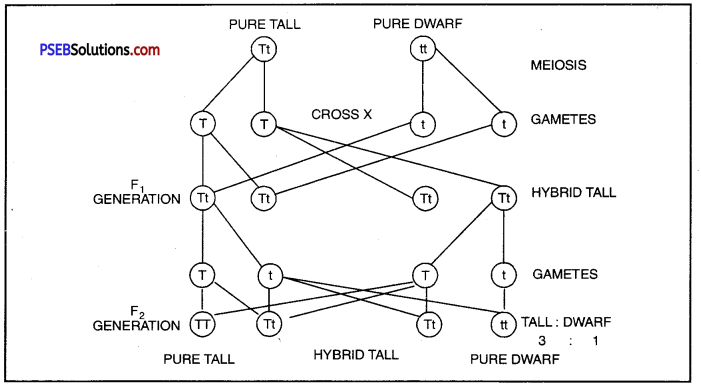
Monohybrid Cross in a Pea Plant
Question 5.
Explain the law of independent assortment with a dihybrid cross.
Answer:
Law of independent assortment. According to this law, the factors of different pairs of contrasting characters, do not influence each other. They are independent of one another in their assortment to form new combination during gamete formation.
Dihybrid cross: A cross in which two characters are taken into consideration during experimentation, such a cross is called dihybrid cross. A cross between a pea plant with yellow smooth and a pea plant with green wrinkled seeds are considered.
Explanation: A cross is made between pea plant having yellow smooth seeds (YYSS) and a pea plant with green wrinkled seeds (yyss). At the time of cross pollination, yellow smooth (YYSS) produce gametes with genes (YS) and green wrinkled will produce gametes with gene (ys). Gametes unite at random. The seeds obtained when placed in soil will grow to form plants and produce seeds which are yellow smooth (YySs) because yellow and smooth characters are dominant over green and wrinkled. These are called as plants of Fi generation.
When plants of Fx generation are allowed to self pollinate gametes formed YS, Ys, yS and ys by meiosis, they unite at random forming seeds. The plants thus obtained were called as F2 generation. They are yellow smooth (YYSS, YySS, YsSS, YYSs); yellow wrinkled (YYss, Yyss), green smooth (yySS, yySs) and green wrinkled (yyss) in the ratio of 9 : 3 : 3 : 1. The result of dihybrid cross can be shown below in the chequer board.
From the above dihybrid cross, it can be derived that each gene is assorted independently of the other during its passage from one generation to the other or Law of Independent Assortment is justified.
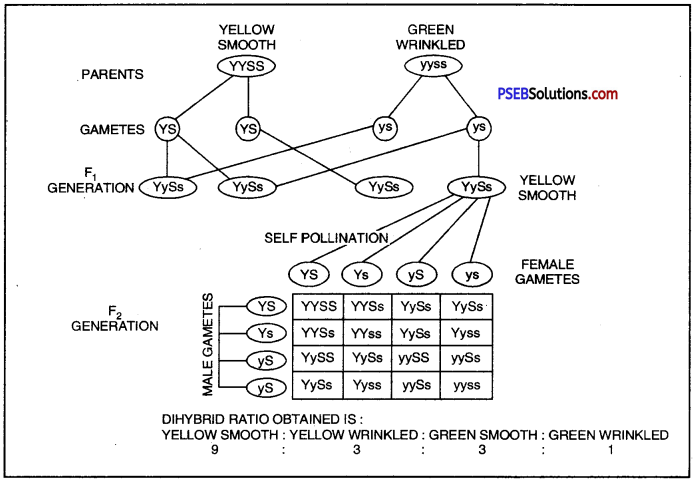
Result of dihybrid cross
Question 6.
State the hypothesis of Oparin and Haldane about the primeval Earth condition. What do you understand by Haldane’s hot dilute soup? State its significance.
Answer:
Alexander I. Oparin (1894-1980), a Russian biochemist and J.B.S. Haldane (1892-1964), a British scientist have put forward the concept of abiogenesis. According to Oparin and Haldane primeval earth had reducing condition and the atmosphere was free from oxygen. Oxygen remained bound in H20 and metallic oxides on the surface of rocks and its particles. The early gas cloud was rich in Hydrogen, in form of methane (CH4 and ammonia (NH3) and water (H2O). The organic molecules formed due to the atmospheric reaction accumulated slowly and gradually in the sea and constitute what is called “hot dilute soup”.
Significance of hot dilute soup. Thus conditions of reducing nature are unable to oxidize these organic compounds which form the basis of life.
Question 7.
Summarise Miller’s simulation experiment for organic synthesis. Comment on its efficacy.
Answer:
Miller’s experiment. Miller (1953) made the first successful simulation experiment to assess the validity of the claim for origin of organic molecules.
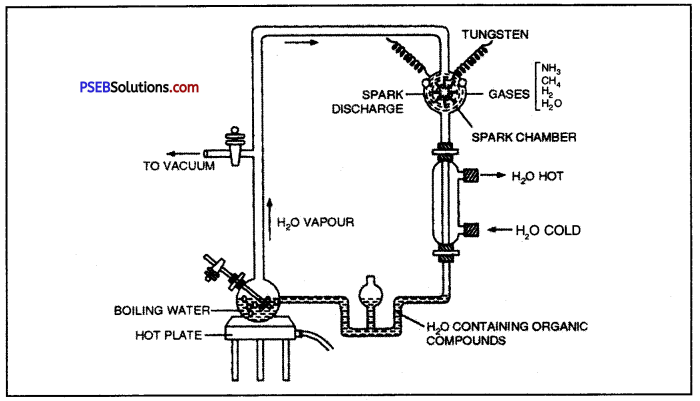
Stanley Miller’s Experiment for the artificial synthesis of organic compounds
Miller sealed in a spark chamber a mixture of water, methane, ammonia, hydrogen gas. He made arrangement for boiling water. The trap in turn, was connected with the flask for boiling water. After 18 days, a significant amount of simple major organic compounds such as amino acids like glycine, alanine and aspartic acid and peptide chains began to appear. Simple sugars, urea and short chain fatty acids were also formed.
Question 8.
How human evolution take place over the years?
Answer:
Human evolution.
The study of human evolution indicates that all of human heings belong to a single species Homo sapiens that evolved in Africa.
- DNA sequences have been used for studying human evolution.
- Due to the diversified human forms and features, skin colour is the common way for identifying the races.
- Few thousand years ago some ancestors left Africa while others stayed back.
- The residents spread across Africa and the migrant spread across the planet from Africa to West Asia, Central Asia, Eurasia, South Asia, East Asia, Indonesia, Philippines, Australia and America.
- They went forward and backward with groups separating from each other, or sometime coming together.
- Like all other species, they were also living their lives to the best of their ability.In atmosphere, this spark is provided by U.V. light or other energy source.
Short Answer Type Questions
Question 1.
What is meant by heredity?
Answer:
Heredity. It is defined as the transmission of characters from parents to offspring or from one generation to the successive generations of living beings.
We observe in our daily life that similarities tend to be greatest between members of a family-between the offspring of parents. Children tend to resemble parents, even grandparents and persons of earlier generations. The similarities are not due to coincidence but rather due to inheritance or heredity.
![]()
Question 2.
What is genetics?
Answer:
Genetics: It is that branch of science which deals with study of heredity (inheritance of characters) and variations. It deals with inborn characteristics of the organisms. Genetics also deals with inborn differences between offsprings of family and related organisms.
Genes are carriers of characters and present on chromosomes. Mendel is considered as “Father of genetics.”
Question 3.
What are the causes of variations in clones?
Answer:
Causes of variations in clones :
Clones have the same genetic make up but variations appear in clones due to following reasons :
- Inaccuracies during DNA copying.
- Effect of environment termed acquired variations.
- Mutations: These are sudden stable abrupt changes and they are discontinuous inheritable as produced due to changes in genetic make up.
Question 4.
Explain the term variation.
Answer:
Variation: No living organisms are alike and they vary appreciably in many structural and functional aspects. These differences between individual organisms are called variations.
Question 5.
(a) Write one difference between continuous and discontinuous variations.
(b) Give differences between germinal and somatic variations.
Or
What do you mean by discontinuous variation?
Answer:
(a) Differences between continuous and discontinuous variations
| Continuous variations | Discontinuous variations |
| They are small indistinct differences from the normal conditions and called fluctuations. | They are large distinct differences from the parents and termed as mutations or sport. |
(b) Differences between germinal variations and somatic variations
| Germinal variations | Somatic variations |
| 1. They are caused due to changes in germ cells. | 1. They are caused due to changes in the somatic cells. |
| 2. These variations are heritable. | 2. They are not heritable. |
Question 6.
What is the importance of variations?
Answer:
Importance of variations :
- They enable the organism to adapt themselves to changing environment.
- They form raw material for evolution and development of new species.
Question 7.
Mention the information source of making protein in the cell. What is the basic event in reproduction.
Answer:
DNA (Deoxyribose Nucleic Acid) directs the synthesis of proteins through mRNA (messenger RNA).
DNA copying is essential part of the process of reproduction.
- DNA copying provides cellular apparatus in the daughter cells.
- DNA in daughter cells will be able to control the functioning of daughter cells.
- DNA copies will retain the traits.
Question 8.
Why did Mendel choose garden pea for his experiments?
Answer:
Mendel selected pea plant (Pisum sativum) because :
- Many varieties were available with observable alternative forms for a trait or characteristic.
- Peas are normally self pollinated; as their corolla completely enclose the reproductive organs until pollination is completed.
- It was easily available.
- It has pure lines for experimental purpose, i.e., they always breed true.
- It has contrasting characters. The traits were seed colour, pod colour, pod shape, flower shape, position of flower, seed shape and plant height.
- Its life cycle was short and produced large number of offsprings.
- The plant is grown easily and does not require care except at the time of pollination.
Question 9.
Make a table showing characters of pea selected by Mendel.
Answer:
Characters of garden pea (Pisum sativum) selected by Mendel
| Heritable variations | Dominant | Recessive |
| 1. Plant height | Tall (T) | Dwarf (t) |
| 2. Flower and pod position | Axial (A) | Terminal (a) |
| 3. Pod colour | Green (G) | Yellow (g) |
| 4. Pod shape | Inflated (I) | Constricted (i) |
| 5. Seed coat | Coloured (C) | White (c) |
| 6. Seed shape | Round (R) | Wrinkled (r) |
| 7. Seed (cotyledon) colour | Yellow (Y) | Green (y) |
Question 10.
What is monohybrid cross?
Answer:
Monohybrid cross. It is a cross in which only one character is considered at a time, e.g., in a cross between tall and dwarf plant, the size of stem is considered. Mendel made a cross between pure tall (TT) and a pure dwarf (tt) pea plant.
He obtained all tall (hybrid) plants in FL generation. On selfing these plants produced tall and dwarf in the ratio of 3:1. The genotypic ratio of 1 : 2 : 1 and phenotypic ratio of 3 : 1 is termed monohybrid ratio.
Question 11.
State and explain principle of dominance.
Answer:
Law of Dominanc J: According to this law, when two factors of a character are unlike, one of them will manifest in the body and is called dominant while the other remains hidden and is termed recessive factor.
The law can be well explained by the monohybrid cross by studying the following crosses :
1. Pure tall = TT, Hybrid tall = Tt
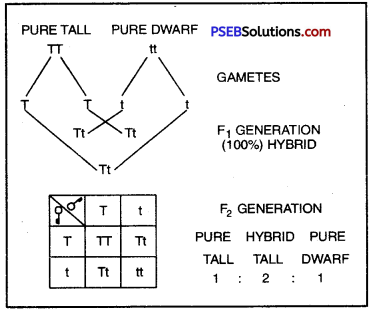
Results of cross between pure tall and pure dwarf
Gametes of TT parent = \(\frac{1}{2}\) T + \(\frac{1}{2}\) T
Gametes of Tt parent = \(\frac{1}{2}\) T+ \(\frac{1}{2}\) t
The 50% are pure tall and 50% hybrid tall. Then pure tall plants will produce 100% tall in F2 generation and hybrid plants will produce in the ratio of 1 : 2 : 1 in the F2 generation.
2. When the cross is made between pure tall and pure dwarf, we get results as follows (Figure)
Question 13.
What is dihybrid ratio?
Answer:
Dihybrid ratio: The ratio obtained in a dihybrid cross is called dihybrid ratio. It is 9 : 3 : 3 : 1.
![]()
Question 14.
What is a gene? What is the nature of gene?
Answer:
Gene: Term gene was coined by Johansen (1900). A hereditary determiner specifying a biological function; a unit of inheritance (DNA) located in a fixed place on the chromosome is called gene.
Mendel considered every character as unit which is controlled by a factor presently called gene. Chemically gene is a segment of DNA which controls one character and physically is a part of chromosome.
Question 15.
Where are genes located? What is the chemical nature of gene?
Answer:
Genes are located on chromosomes. Chemically gene is a segment of DNA (Deoxyribose nucleic acid).
Question 16.
In man four types of blood groups A, B, AB and O are controlled by three alleles of a gene. What is the mechanism of inheritance of the blood groups?
Answer:
More than two forms exists for certain genes. It is an example of multiple alleles. A well known example is ABO blood types in human. The four human blood groups, A, B, AB and O are phenotypes of the trait.
Three different alleles IA, IB and i of gene determine the phenotypes of the four blood groups. The six types of genotypes are as follows :
| Phenotype (Blood Group) | Genotype |
| O | ii |
| A | IAIA or IAi |
| B | IBIB or IBi |
| AB | IAIB |
Both IA and IB are dominant over i. Since a person with genotype IAIB has AB blood groups. It is an example of codominance.
Thus ABO blood groups exhibit three genetic aspects :
- Dominant-recessive mechanism.
- Multiple alleles
- Co-dominance.
Question 17.
A man with type A blood has a wife with type B. They have a child with type O blood. Give the genotype of all the three. What other blood groups can be expected in the future offspring of this couple?
Answer:
Genotypes. Man (IA IO), Mother IB IO and child IOIO.
Blood group of the future offspring. A type, B type, o type and AB type. It is based on the following cross :

Question 18.
Define genetic engineering. Write applications of genetic engineering.
Answer:
Genetic Engineering: The method of artificial synthesis of new genes and their subsequent “transplatation” in the genome of an organism or methods of correcting the defective genes is called genetic engineering.
Applications of genetic engineering
- Genetic engineering has introduced a new form of medicine called gene therapy which may be used in treating, crippling, hereditary diseases like haemophilia, phenylketonuria.
- With the help of genetic engineering it may be possible to produce new plants and animals having a new design and specific character according to will.
- Gene coding for vitamins, antibiotics or hormones from higher animals to bacteria is also possible which will help to produce chemicals which are impossible to get or to synthesise.
Question 19.
Give a graphic representation of mechanism of gene expression.
Answer:
Mechanism of gene expression
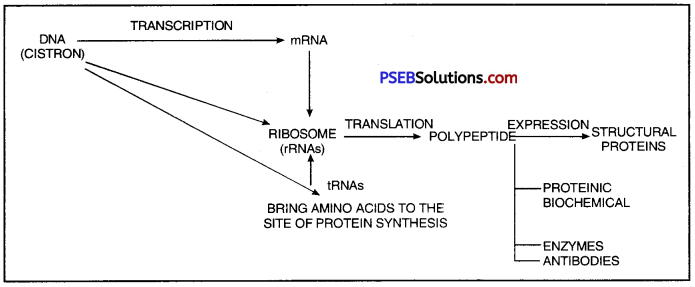
Question 20.
What do you understand by origin of life? Explain.
Answer:
Origin of Life. The oldest surviving terrestrial rocks, about 4.3 billion years old, contain no definite trace of life, at least not recognisable,as yet. Some rocks, about 3.9 billion years old, contain carbonates. Geologists interpret that these carbonates have resulted from life processes. Therefore, life was present on Earth about 3.9 billion years ago. However, the oldest microfossils discovered so far are that of photosynthetic cyanobacteria.
Question 21.
Write the contribution of Urey and Miller.
Answer:
Urey and Miller conducted experiment which supported that life originated by chemosynthesis. The chemosynthetic theory (Oparin-Haldane) states that life originated from non-living matter is based on the presence of methane and ammonia in the atmosphere. It required a high temperature, high energy radiations and electric discharges.
Question 22.
What are homologous organs? Give examples.
Answer:
Homologous organs. The organs of different classes have different forms because they have to perform different functions but their structures basically remains similar. Such organs are called homologous organs.
Examples of homologous organs. 1. The wings of bird and bat, flipper (fin) of whale, structure of human forearm are different in forms because these have to perform
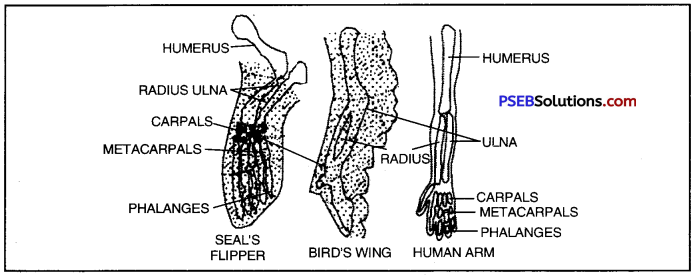
Homologous organs
different functions. Studies of the bones forming the skeleton of these organs, would reveal similarity in construction. In fact, these are the forms of fore-arms which have originated from pentadactyl forms and due to the different functions they are performing hence transformed into different forms.
2. In plants, the homologous organs may be a thorn of Bougainvillea or a tendril of cucurbita both arising in axillary position.
Question 23.
What are analogous organs? Give examples.
Answer:
Analogous organs. The organs which are similar in appearance and perform the same function but differ in their fundamental structure and origin are called analogous organs.
Examples:
- Wings of birds and insects.
- Leaves of a plant and cladodes of Ruscus are also analogous organs.
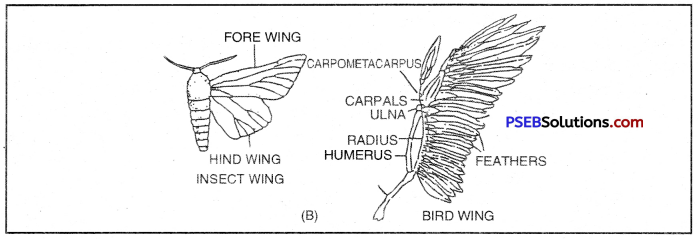
Wings of insect and bird
Question 24.
Differentiate homologous organs and analogous organs.
Answer:
Differences between homologous organs and analogous organs
| Homologous Organs | Analogous Organs |
| 1. Some organs of different organisms resemble in structure and bear the same relation to the body. | 1. These organs which are functionally similar but morphologically different are called analogous organs. |
| 2. They have same fundamental plan of structure e.g. leaves of all higher plants arise from the nodes and bear an axillary bud in their axils. | 2. Their basic structure is different e.g. wings of vertebrates and insects perform the same function of flying. |
Question 25.
Are the fossils being formed at present time?
Answer:
Fossil formation. Fossilization of a dead organism or its parts usually begins when it is buried before it has a chance to decay. The organism sinks into a bog or a marsh or to the bottom of a lake, sea or river. In some cases it is buried by wind-driven sands. Even after burial decay can occur so that soft body parts decompose, a fact which emphasizes again that the hard parts are the ones that mou commonly persist as fossil. The buried parts that do not decay are preserved and mud or sand hardens to rock, the fossil becomes entombed.
Fossilization is a hit or miss effect. Only those organisms become fossilized that happen to die in a spot where they can be buried by natural process before their carcasses are destroyed by scavengers. Thus under such conditions fossils are being formed at the present time.
Question 26.
What is the physical method of determining the age of fossils?
Answer:
Determination of age of fossils (dating of fossils). Once the fossils are unearthed palaeontologists try to determine their position in the historical sequence of life. The absolute age of fossil is difficult to calculate because older the fossil, less precise is tne calculation.
Physical method. Before we begin to determine the age of fossil, we have to gain some perspective about the age of earth.
The age of the earth is estimated to be near about 300 crore years. This life span of earth has been divided into six principal eras. Out of these, three eras are subdivided into smaller span known as periods or epochs.
Question 27.
Discuss the importance of artificial selection in the derivation of the concept of natural selection.
Answer:
Importance of artificial selection. From his enquiries on breeding domesticating plants and animals, Darwin obtained clear evidence for selection, in this case of artificial selection. The breeders selected and perpetuated those variant types that interested them or seemed to be useful to them. Similar to artificial selection, natural selection also controls the speciation. But natural selection is too slow to observe.
Question 28.
Distinguish between microevolution and macroevolution. Narrate the significance of population genetics in evolution.
Answer:
Evolution on the grand scale of geological time, is called macroevolution while evolution at genetic level is microevolution. Microevolution is actually operative at genetic level change.
Significance of Population Genetics. The gene frequency of a population is called population genetics. Evolution occurs within populations as the relative frequencies of different variations of DNA change over time. If genes change, then enzymes automatically change and represent two different forms of individuals and definitely result in evolution.
Question 29.
What is variation? Name the basic processes that cause variations among organisms. Discuss the role of migration in evolution.
Answer:
Variations: The features which differ among the individuals are called variations.
Causes of variation: Mutation, recombination, gene migration, genetic drift and natural selection.
Role of Migration: Few populations are isolated from the other populations of same species, usually some migration takes place if the migrating individuals breed within the new population then immigrant will add new alleles to the local gene pool of host population.
Question 30.
Define variations in relation to species. Why is variation beneficial to the species?
Answer:
Variation. No living organisms are alike and they vary appreciably in many structural and functional aspects. These differences between individual organisms are called variations.
The useful variation in individuals of a species will enable them to adapt according to the changes and new needs. Thus they will enable the survival of the species.
Question 31.
Explain Genetic Drift.
Answer:
Genetic Drift: The term genetic drift refers to the chance elimination of the genes of certain traits when a section of population migrates or dies of natural calamity. It dramatically alters the gene frequency of the remaining population. It eliminates certain alleles and fixes the other alleles, thereby reducing the genetic variability of the population. For example, in case of snowstorm, the individuals having alleles (characters) that provide resistance to cold survive, whereas others die.
![]()
Question 32.
What is reproductive isolation?
Answer:
Reproductive isolation. Speciation is not likely to occur simply by changes in the genotype of a population. The populations with different genotypes appearing in them must be isolated so that differences may accumulate to the level of speciation. Else interbreeding of emerging populations will result in mixing of their genotypes and disappearance of differences between them. Isolation preserves the integrity of a species by checking hybridisation.
Question 33.
Give a brief account of present day concept of evolution.
Answer:
Present day concept of evolution
- appearance of genetic variations in certain individuals of a population by
- migration
- non-random mating
- genetic drift
- chromosomal changes
- gene mutation
- recombination of genes, and
- hybridization.
- spreading of genetic variations in a sub-group of a population by natural selection through differential reproduction in successive generations.
- some sort of reproductive isolation of a subgroup of population having the genotypes selected by nature from other subgroups, and
- accumulation of genetic variations to sufficiently alter the individuals of the subgroup to become a new species.
Question 34.
How is the equal genetic contribution of male and female parent ensured in the progeny?
Answer:
In sexual reproduction, both the parents contribute equal amount of genetic material (genes) to the offspring. This means that for each trait there will be two alternatives in the sexually reproducing organisms. Out of these two alternatives, one is called dominant trait and the other is called recessive trait. There will be some progeny with new combination. DNA controls the traits and are copied from one generation to the next generation. Inaccuracies do occur during DNA copying which is more prominent in sexual reproduction. These variation in DNA copying gets inherited. Accumulation of variation generation after generation altogether leads to evolution of a new species.
Question 35.
How does the creation of variations in a species ensure survival?
Answer:
Genetic variations arise in sexually producing organisms as a result of following mechanism.
- Crossing over during gamete formation.
- Random segregation of chromosome during meiosis at the time of gamete formation.
- Random rejoining of gametes having different genetic set up in the chromosomes during fertilisation.
- These variations form the raw materials of evolution.
Only variations that confer an advantage to an individual organism will survive in a population.
The organism with useful variations will adapt and survive. Moreover they leave behind more offsprings and populations with such genetic variations will survive.
Very Short Answer Type Questions
Question 1.
How are new organisms formed?
Answer:
New organisms are produced as a result of reproduction.
Question 2.
Do you find more variation amongst human or in sugarcane fields.
Answer:
Human beings show more variations.
Question 3.
What do the progeny get from parents?
Answer:
Inherited traits and variations.
Question 4.
What special features you find in second generation?
Answer:
The members of second generation inherit some characters from their parents and new variations are also produced.
Question 5.
Organisms reproducing by asexual reproduction show a few variation.
Answer:
These organisms carry out mitosis during reproduction. As there is no meiosis no new combinations of characters are formed.
Question 6.
What is the basis of evolution?
Answer:
Variations are raw materials of evolution.
Question 7.
What are functional unit of hereditary material?
Answer:
Genes.
Question 8.
Coin the term for transfer of characters from parents to offspring.
Answer:
Heredity/Inheritance.
Question 9.
Who is the Father of Genetics?
Answer:
Gregor Mendel.
Question 10.
Mendel worked on which plant having alternate traits?
Answer:
Pisum sativum (garden pea).
Question 11.
Mention any two of the seven contrasting traits of garden pea selected by Mendel.
Answer:
- Height-Tall/Dwarf
- Seed shape-Round/Wrinkled.
Question 12.
What is dominance?
Answer:
The expression of heritable trait present is heterozygous condition.
Question 13.
What is recessive?
Answer:
An allele that is not expressed phenotypically when present in heterozygous conditions.
Question 14.
Information for synthesis of proteins is stored in which part of cell.
Answer:
DNA.
Question 15.
What is gene for protein?
Answer:
Segment of DNA which directs synthesis of protein is called gene for protein.
Question 16.
Name the structure or mole-cules which control the traits.
Answer:
Gene.
Question 17.
Name the carriers of genes.
Answer:
Chromosomes.
Question 18.
What is gene according to molecular structure?
Answer:
A segment of DNA that provides information for the synthesis of gene for protein is called gene.
Question 19.
Name the alternative form of gene.
Answer:
Allele.
Question 20.
How many pairs of chromo-somes are present in male/female human?
Answer:
23 pairs.
Question 21.
Write sex-chromosome of female.
Answer:
XX.
Question 22.
Write sex-chromosome of male.
Answer:
XY.
Question 23.
Which chromosome determine the sex of child.
Answer:
XX-chromosome in female and XY-chromosome in male.
Question 24.
If in vegetation of green plants, what will happen if green beetles are not distinguished as compared to red beetles.
Answer:
The population of green beetles will increase and subsequently red population will decrease.
![]()
Question 25.
What is evolution?
Answer:
Descend with modifications is termed evolution.
Question 26.
What is the basis of evolution?
Answer:
Variations are the basis of evolution.
Question 27.
What is the effect of starvation on DNA in beetles?
Answer:
No effect.
Question 28.
What are the causes of inbuilt tendency of variations?
Answer:
- Sexual reproduction
- Errors in DNA copying
Question 29.
Why crows could not eat coloured beetles?
Answer:
Crows could not see green coloured beetles as they get matched with green leaves and bushes.
Question 30.
What is meant by the term extinction?
Answer:
Elimination of a species is termed extinction.
Question 31.
What is the basis of Darwin’s theory of evolution?
Answer:
Natural selection/Survival of the fittest.
Question 32.
Who proposed the theory of origin of life from abiotic chemicals?
Answer:
Haldane.
Question 33.
Name the scientist who conducted experiments to prove abiotic origin of life?
Answer:
Stanley Miller and Urey.
Question 34.
What is genetic drift?
Answer:
It refers to chance elimination of genes of certain traits when a section of a population dies or migrates.
Question 35.
Define macroevolution.
Answer:
Macroevolution involves large scale changes among group of species
Question 36.
Genetic drift occur in small or large population.
Answer:
Small in number.
Question 37.
What is the structural unit of life?
Answer:
Cell.
Question 38.
Name a cell without nucleus.
Answer:
Micro-organism (Bacteria).
Question 39.
What is fossil?
Answer:
Fossils are preserved remains, traces of organisms that lived in the past.
Question 40.
The species sharing more common characteristics will be close or distant related?
Answer:
Closely related.
Question 41.
Give the three key factors of the modern concept of evolution.
Answer:
Genetic variations, natural selection and isolation.
Question 42.
What is the cause of sickle-cell anaemia?
Answer:
Gene mutation which changes the composition of haemoglobin and shapes of RBCs.
Question 43.
Name any fossil animal which serves as connecting link. Which two groups does it connect?
Answer:
- Archaeopteryx
- It is a connecting link between reptiles and birds.
Question 44.
What are factors of Mendel?
Answer:
Genes.
Question 45.
What is the modern term given to the factor of Mendel?
Answer:
Gene is the fector of Mendel; It is chemically a segment of DNA.
Question 46.
Coin one word for a class of individuals which are morphologically similar.
Answer:
Phenotype.
Question 47.
Coin the term for the character which does not allow the expression of a contrasting character in a hybrid.
Answer:
Dominant.
Question 48.
Coin the term for individual which breed true for its character.
Answer:
Homozygous.
![]()
Question 49.
What are inherited traits?
Answer:
Inherited traits. The distinguish-able feature of a character is called a trait. The traits which are passed from parents to offsprings are called inherited traits.
Question 50.
What is Mendel’s monohybrid ratio?
Answer:
3 :1.
Question 51.
Write down Mendel’s dihybrid ratio for phenotypes.
Answer:
9 : 3 : 3: 1
Question 52.
Write the genotype of man with blood group ‘A’.
Answer:
IAIA, IAI°.
Question 53.
What are two major functions of DNA?
Answer:
Replication and expression of genetic information in the form of poly-peptide (Protein).
Question 54.
Define speciation.
Answer:
Origin of species is termed speciation.
Question 55.
What is paleontology?
Answer:
Study of fossils is termed paleontology.
Question 56.
What are the kinds of organs shown in the figure?
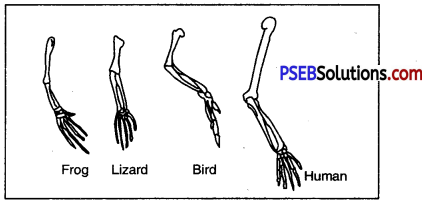
Answer:
Homologous organs.
Question 57.
What are the kind of organs shown in the figure?
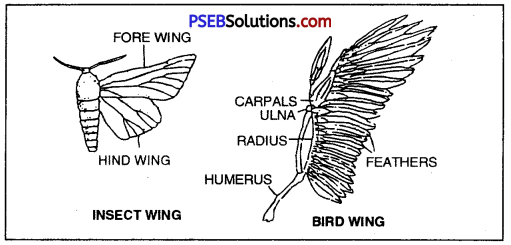
Answer:
Analogous Organ.
Question 58.
Write the blood group of progeny P and Q.
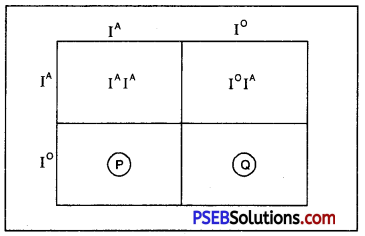
Answer:Blood group of P = A
Blood Group of Q = 0
Question 59.
What are vestigial organs?
Answer:
These are organs of the body which are non-functional in the possessor but were functional in the ancestralss and related organism.
Question 60.
Write any four vestigial organs of human.
Answer:
Muscles of ear lobes, appendix, wisdom tooth, hair of chest.
Question 61.
State ‘Biogenetic law’.
Answer:
Ontogeny repeats phylogeny.
Question 62.
Name the gases used by Urey and Miller for their experimnt.
Answer:
CH4, NH3, H2 and H2O.
Question 63.
What is biogenesis?
Answer:
Life is always formed from pre-existing life.
Question 64.
What is locus?
Answer:
Site of gene on a chromosome is called locus.
Question 65.
In the diagram what is the sex of (A) and (B)?
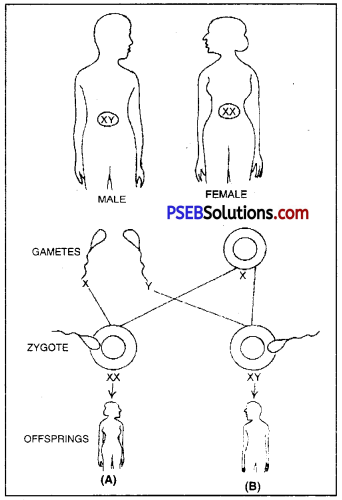
Answer:
The sex of (A) is female (XX) The sex of (B) is male (XY)
Multiple Choice Questions
Question 1.
Branch of biology deals with heredity and variation is called
(A) Paleontology
(B) Evolution
(C) Genetics
(D) Ecology.
Answer:
(C) Genetics
Question 2.
The factors which represent the contrasting pairs of characters are called
(A) Dominant
(B) Recessive
(C) Determinants
(D) Alleles.
Answer:
(D) Alleles
Question 3.
Two allelic genes are located on
(A) the same chromosome
(B) two homologous chromosomes
(C) two non-homologous chromosomes
(D) any two chromosomes.
Answer:
(B) two homologous chromosomes
Question 4.
Mendel’s law of segregation is based on separation of alleles during
(A) gamete formation
(B) seed formation
(C) pollination
(D) embryonic development.
Answer:
(A) gamete formation
![]()
Question 5.
The ratio of phenotype in F2 generation of a dihybrid cross is:
(A) 3:1
(B) 1:2:1
(C) 2:1
(D)9:3:3:1.
Answer:
(D) 9: 3 : 3: 1
Question 6.
The composition male sex chromosomes is :
(A) XX
(B) XYX
(C) YXY
(D) XY.
Answer:
(D) XY
Question 7.
How many pairs of chromosomes are present in male and female?
(A) 33
(B) 43
(C) 23
(D) 46.
Answer:
(C) 23
Question 8.
Who postulated ‘the natural selection’ as the basis of evolution ?
(A) Darwin
(B) Haldane
(C) Lamark
(D) Newton.
Answer:
(A) Darwin
Question 9.
How many years back human has started to grow the wild cabbage as food?
(A) 20
(B) 200
(C) 2000
(D) 20000.
Answer:
(C) 2000
Question 10.
How the age of fossils is determined?
(A) fossil dating
(B) DNA
(C) gene
(D) biological evolution.
Answer:
(C) gene
Fill in the blanks:
Question 1.
_________ are units of heredity.
Answer:
Genes.
Question 2.
There are _________ pairs of chromosomes in human.
Answer:
23.
Question 3.
Site of gene on a chromosome is called _________
Answer:
Locus.
Question 4.
Continuity of life is maintained through _________ and _________
Answer:
Genetics and Evolution.
Question 5.
Mendel formulated Law of purety of gametes on the basis of _________
Answer:
Dihybrid cross.
Question 6.
The composition of female sex-chromosomes is _________
Answer:
XX.
Question 7.
Wing of butterfly and wing of birds are examples of organs.
Answer:
Analogous.